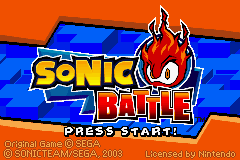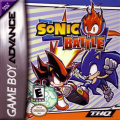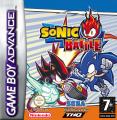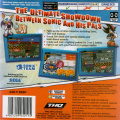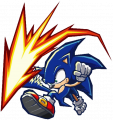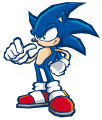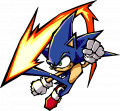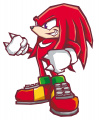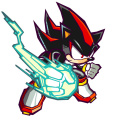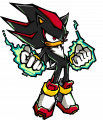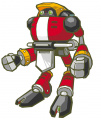Sonic Battle
From Sonic Retro
Revision as of 15:35, 16 May 2009 by Scarred Sun (talk | contribs)
| Sonic Battle |
|---|
| System(s): Game Boy Advance |
| Publisher: Sega |
| Developer: Sonic Team |
| Genre: Fighting |
Sonic Battle was a 4 player isometric fighting game based on the Sonic Adventure era characters, differing heavily from Sonic the Fighters, the first Sonic fighting game. It had a single player story mode - which, debatedly, has the best story in the entire series; it doesn't take itself too seriously and gives us a better look at the characters.
The story centered around the ancient mechanoid Emerl. Emerl could be upgraded, but it was long and tedious to do this, which some gamers found to detract from the game. He gains XPs from each fight, but about 10 fights would need to be completed to gain a new move.
It is also the first Sonic game to feature swearing - in Japan, Rouge calls Eggman a "bastard" for hacking into a computer before she did. The Japanese version actually has a english translation in it which contains the swearing. When the game was released in the US the dialogue was altered.
Contents
Gameplay
Battles are fought in 3D arenas with up to 4 players. Each character has a set of attacks and abilities. The majority of attacks are performed with the ![]() button, including the combos (1st, 2nd, and 3rd Attack), Air Attack, Upper Attack (used to knock opponents straight up), Heavy Attack (used to knock opponents away), and Aim Attack (used to home in on an opponent after the Heavy Attack). The
button, including the combos (1st, 2nd, and 3rd Attack), Air Attack, Upper Attack (used to knock opponents straight up), Heavy Attack (used to knock opponents away), and Aim Attack (used to home in on an opponent after the Heavy Attack). The ![]() button is used to jump, and the
button is used to jump, and the button lets the player block attacks, or replenish health if the button is held.
The playable characters also have unique special moves, the three types being Shot, Power, and Set. Shot moves are projectiles which can damage an opponent from a distance. Power moves can deal damage quickly in a single move. Trap moves generally involve using a type of bomb to surprise-attack the enemy. However, only a limited number of special moves can be selected. Shot, Power, and Trap must be allocated to three slots: Ground, Air, and Defend. The special move you set to Ground will be used when you press on the ground. The move you set to Air will be used when you press
in mid-air. The last slot, Defend, has a different function; When you set a certain type of special move to Defend, then every time an enemy uses the same type of special to attack you, you'll automatically block it.
Each player has a health bar and an Ichikoro Gauge. When health is completely depleted, the player is KO'd and loses one life (in a survival match) or the one who KO'd them gets a point (in a KO match). The Ground, Air, and Defend settings are chosen at the beginning of the match, and every time the player respawns. As a player takes damage, blocks attacks, or heals, the Ichikoro Gauge fills up. When it is full, the next special move the player does will instantly KO anyone it hits. However, if they chose to defend against that type of special, or successfully block, their Ichikoro Gauge will be filled instantly. Players healing damage will also slowly fill up their Ichikoro Gauge, but are still vulnerable to attacks.
Emerl
The main gimmick of the game is called the Skill Capture system. Emerl can imitate the actions and attacks of every other character. He starts out with slow, incomplete captures of Sonic's abilities, which serve as the default moves. As the game is played, the abilities of other characters are recorded as Skill Cards. After each fight, certain skills are captured this way, one card per character per fight (so if Emerl fought Tails, he would get a Tails data card, and if he fought Sonic, he would get a Sonic data card.) The capturable actions consist of not only the attacks and special moves each character performs, but their individual abilities in running, jumping, mid-air actions, and the like. These can be allocated to their corresponding slots in Emerl's ability list, and doing so gives Emerl the new moves to use in battle. (Note: What the charaters do ingame does not determine what the Skill Card will be.) Sometimes you will get a rare skill such as one of the skills on the third page of Emerl's skill-edit list (ex: fight pose, color 1, attack support). There are 309 skill cards to collect in all, though the rarest can't be acquired by fighting combatants in normal battles. Emerl's ultimate battle cards can only be earned through Tails' virtual training in the final chapter of Story Mode. Secret character-centric abilities can only be obtained via passwords.
However, all these abilities cannot be used simultaneously. A limit is placed on the amount of non-default Skill Cards that can be used, in the form of skill points. Each card has a certain number of stars shown on the corner, and for each star, five skill points must be available to use on it. The total number of required skill points of all the allocated Skill Cards cannot exceed the current maximum of skill points Emerl has accumulated. Like the Skill Cards themselves, the skill point maximum is increased slightly with each battle, to a maximum of 500.
Since Emerl is powered by the Chaos Emeralds, there are cutscenes in the Story Mode episodes in which the Emeralds are used to enhance Emerl's abilities. Each Emerald raises the skill point maximum by 10, a rather large amount considering that most of the time, individual battles raise it by 1-5 (depending on performance). The player can choose to replay a Story Mode episode after it's been completed, but the Skill Card/Point data is still saved. Oddly enough, the skill point maximum is raised at the Chaos Emerald cutscene every time the player reaches them. This means the same Story Mode episode can be repeated to raise Emerl's skill points faster than normal.
Manuals
Also Released On
- 2 in 1: Sonic Advance & Sonic Battle for the Gameboy Advance (2005)
- 2 in 1: Sonic Battle & ChuChu Rocket! for the Gameboy Advance (2005)
- 2 in 1: Sonic Pinball Party & Sonic Battle for the Gameboy Advance (2005)
Production Credits
Producer: Yuji Naka
Director: Tomoyuki Hayashi
Battle Mode Planner: Tomoyuki Hayashi
Story Mode Planner: Asahiko Kikuchi
Planning Support: Mizuki Hosoyamada, Ai Mashima
System & Com Programmer: Yoshihiko Toyoshima
Story Mode Programmer: Takahiro Hamano
Battle Mode Programmer: Tomoyuki Hayashi
Minigame Programmers: Nobuo Nakagawa, Yoshihiko Toyoshima
Chief Animator: Yasuda Denneikoushi
Character Animators: Sachi Nakamura, Asao Furukawa, Hiroaki Ishige, Ryuta Kawasaki, Kentaro Sakamoto
Map Designer: Toru Kawaguchi
Advertise Designers: Takeshi Ichimura, Miho Hyakutake, Takao Kawase
Minigame Designer: Takao Kawase
Illustrator: Hisanobu Kometani
Design Coordinator: Yuji Uekawa
Character Design Support: Hiroshi Tanigawa, Tomoki Miyazaki, Arito Chujo, Noriko Shibuya, Norichika Neguro, Masaru Kuribayashi
Special Thanks: Yasuko Maruyama
Sound Created By: Wave Master
Sound Creators: Tatsuyuki Maeda, Kenichi Tokoi, Hideaki Kobayashi
Character Voices (Japanese): Jun'ichi Kanemaru (Sonic the Hedgehog), Ryo Hirohashi (Miles "Tails" Prower), Nobutoshi Kanna (Knuckles the Echidna), Taeko Kawata (Amy Rose), Taiten Kusunoki (E-102 Gamma), Kouji Yusa (Shadow the Hedgehog), Rumi Ochiai (Rouge the Bat), Sayaka Aoki (Cream the Rabbit), Chikao Otsuka (Dr. Eggman)
Character Voices (English): Ryan Drummond (Sonic), William Corkery (Tails), Scott Dreier (Knuckles), Jenny Douillard (Amy), Jon St. John (Gamma), David Humphrey (Shadow), Lani Minella (Rouge), Sarah Wulfeck (Cream), Deem Bristow (Eggman)
Sega Corporation
Executive Management: Hideki Okamura, Masanao Maeda, Toshihiro Nagoshi, Yukio Sugino
Marketing Dept.: Miutsuru Takahashi, Naoko Ooka, Marino Takeda
Public Relations: Yasushi Hagumo, Youko Nagasawa
International Business & Product Development: Tatsuyuki Miyazaki, Yusuke Suai
Sega Logistics Service Co., Ltd
Product Management: Junichi Shimizu
Product Support: Akira Nishkawa, Akira Terasawa, Kazuhiko Morii
Product Test: Yutaka Kawasaki, Daisuke Izichi, Satoshi Yamane, Junko Ota, Sou Ishida
Package & Software Manual Production: Yoshihiro Sakuta, Satoru Ishigami, Kazuaki Jikuhara, Hisakazu Nakagawa, Asako Niyajima
Customer Support: Kazunori Yagi, Shoko Goto
Sega of America, Inc.
Director Of Product Development: Osamu Shibamiya
Localization Producer: Jason Kuo
Test Director: Deborah Kirkham
Project Lead: Shawn Dobbins
Executive Vice President: Shinobu Toyoda
Product Manager: Heather Hall
Senior Media Specialist: Teri Higgins
Creative Services Manager: Arianne Mccarthy
Public Relations Manager: Bret Blount
Special Thanks: Yosuke Moriya, Lori Von Rueden, Klayton Vorlick
Sega Europe, Ltd.
President/COO: Naoya Tsurumi
Executive Vice President Sales & Marketing: Mike Sherlock
Executive Vice President Product Development: Jin Shimazaki
Localization Producer: Akiko Uchida
Senior Producer: Matt O'Driscoll
Technical Producer: Elliott Martin
European Marketing Director: Matthew Woodley
European Marketing Manager: Gary Knight
European Product Manager: Mat Quaek
QA: Darius Sadeghian, David Smith, Roy Boateng, Chris Geiles
Executive Producer: Hisao Oguchi
Resources
Scans
Artwork
Wallpaper
Official wallpaper available from the Sonic Team website:
| Sonic the Hedgehog games for the following systems | |
|---|---|
| 2001 Sonic Advance | Tiny Chao Garden 2002 Sonic Advance 2 2003 Sonic Pinball Party | Sonic Battle 2004 Sonic Advance 3 | Sonic X: A Super Sonic Hero 2005 Sonic Advance & Sonic Pinball Party | Sonic Advance & ChuChu Rocket! | Sonic Advance & Sonic Battle | Sonic Battle & ChuChu Rocket! | Sonic Pinball Party & Sonic Battle | Sonic Pinball Party & Columns Crown 2006 Sonic the Hedgehog Genesis Demos Sonic Advance 3
| |
